|
|
|
Sort Order |
|
|
|
Items / Page
|
|
|
|
|
|
|
| Srl | Item |
| 1 |
ID:
127487
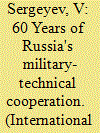

|
|
|
|
|
| Publication |
2013.
|
| Summary/Abstract |
THE SOVIET Chief Engineering Directorate (GIU, now FSVTS - the Russian Federal Service for Military-Technical Cooperation) was established in accordance with the USSR Council of Ministers Resolution No. 6749 of May 8, 1953. Colonel-General G.S. Sidorovich became the first chief of the GIU with a staff of 238 (160 army officers and 78 civilian employees), his deputies being Engineer Colonel M.A. Sergeychik and Rear Admiral G.V. Yurin.1
Of course, Soviet cooperation with foreign countries in the military-technical sphere had begun long before that, although perhaps it was from this time that it began to directly influence the foreign policy of our country.
|
|
|
|
|
|
|
|
|
|
|
|
|
|
|
|
| 2 |
ID:
118714
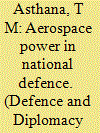

|
|
|
| 3 |
ID:
126586


|
|
|
|
|
| Publication |
2013.
|
| Summary/Abstract |
Using the 'achievement index', a country's relative size of gross domestic product divided by its relative size of population, I argue that the high-achieving position of the West, as a structural distortion, has been a principal source of instability in the modern international system. Rather than being just unsatisfied great powers, large high achievers and stagnant low achievers engage in hegemonic and counter-hegemonic warfare, respectively. Both hierarchy and balancing systems are structurally more stable if they are 'natural' and less stable if they are 'unnatural', with being natural defined as an achievement index of 1. The rise of the rest constitutes a long-term trend back to nature, beginning to flatten the heretofore skewed international structure, which lessens one source of modern system-level instability. With a much larger share of world population, China cannot rise to the same relative height as the West that rose with a much smaller share of the population. China's rise is thus unlikely to repeat the past experience of the rising West.
|
|
|
|
|
|
|
|
|
|
|
|
|
|
|
|
| 4 |
ID:
133253
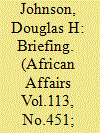

|
|
|
|
|
| Publication |
2014.
|
| Summary/Abstract |
ON 16 DECEMBER 2013 THE PRESIDENT of the Republic of South Sudan, Salva Kiir Mayardit, appeared on state television in military uniform to announce that he had successfully put down a coup attempt in the capital, Juba. The coup attempt was said to have been led by former Vice-President Riek Machar and several ex-cabinet ministers and officials of the ruling Sudan People's Liberation Movement (SPLM), including Madame Rebecca Nyanding de Mabior, the widow of the SPLM's first leader, John Garang. Eleven alleged coup plotters were arrested in their homes, but Riek Machar escaped from Juba, and, amid reports over the next few days of targeted killings of Nuer in Juba by men in uniform loyal to the President, the commanders of the 8th and 4th army divisions of the Sudan People's Liberation Army (SPLA) in Jonglei and Unity states announced their defection to Riek Machar and seized control of the state capitals of Bor and Bentiu. In telephone interviews from secure places Riek Machar denied that he had been involved in a coup but then urged the army to overthrow Salva Kiir and announced his plans to march on Juba.
|
|
|
|
|
|
|
|
|
|
|
|
|
|
|
|
| 5 |
ID:
130688


|
|
|
|
|
| Publication |
2014.
|
| Summary/Abstract |
The article focuses on the crisis in Russian Science, particularly Military Science. Topics presented include the crisis in military science as discussed by N.M. Vasilyev on his paper "On the Crisis in Military Science and Ways of Dealing with It," published by Military Thought journal, differences between military art and science, dialectics and materialism as scientific methodology.
|
|
|
|
|
|
|
|
|
|
|
|
|
|
|
|
| 6 |
ID:
134107
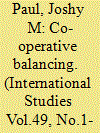

|
|
|
|
|
| Publication |
2014.
|
| Summary/Abstract |
The Asia-Pacific region is facing the threat of a number of potential military conflicts. Unresolved security challenges include the Sino-Japanese and Sino-Indian territorial disputes. The current peace and stability in the region has been achieved through various multilateral mechanisms and constant US involvement in the regional affairs. However, the declining US presence in Asia, the ineffectiveness of different multilateral institutions to establish a security order in the region and China's possible emergence as a great power in Asia may lead to the end of the status quo. In this context, it is pertinent that Asia should be free from both hegemony and power rivalry, and for that, 'co-operative balancing' is the best possible mechanism to achieve a long-term peace and stability. Co-operative balancing is a combination of power balancing and a co-operative security framework. It promotes the independent position of individual countries and strengthens the multilateral mechanisms. This essay concludes that India and Japan can balance against China while bilateral engagement among the three countries tends to reduce their distrust vis-à-vis China.
|
|
|
|
|
|
|
|
|
|
|
|
|
|
|
|
| 7 |
ID:
084552
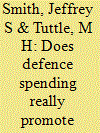

|
|
|
|
|
| Publication |
2008.
|
| Summary/Abstract |
Many studies have examined the relationship between defense spending and growth in real aggregate output with mixed results. Most recently, Atesoglu (2002) finds a positive relationship between defense spending and output. Capturing the error correction term as the long run adjustment parameter and including the long run adjustment in the relationship, we do not find evidence that defense spending promotes growth in real output. Instead, defense spending responds to aggregate income shocks. We re-estimated the relationship and dummied all US military conflicts with similar results concerning military spending's effect on output. Interestingly, we find trade-offs between defense and non-defense government spending during war time.
* The views expressed in this paper are those of the authors and do not necessarily reflect the official policy or position of the US Air Force, the Department of Defense, or the US Government. The authors would like to express their thanks for the comments from Craig Stone and the other participants at the 2006 Canadian Economics Association conference, as well the comments received from three anonymous referees and the editor.
|
|
|
|
|
|
|
|
|
|
|
|
|
|
|
|
| 8 |
ID:
132317
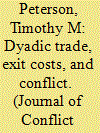

|
|
|
|
|
| Publication |
2014.
|
| Summary/Abstract |
Most studies of the link between dyadic trade and militarized conflict examine the extent of trade interaction. However, interaction measures do not account for the impact of cutting off trade (i.e., exit costs). In this article, I highlight the link between exit costs, the cost of conflict, and "the spoils of conquest," arguing that one state's exit costs are associated with higher incidence of dyadic conflict when its trade partner's exit costs are low. However, its exit costs become less aggravating-and eventually pacifying-as its trade partner's exit costs increase. I test this argument by estimating import demand and export supply elasticities, developing yearly exit cost measures for directed dyads, 1984-2000. Statistical tests confirm that unilaterally high exit costs are aggravating, but that jointly high exit costs are pacifying, a pattern most prominent for trade in strategic commodities.
|
|
|
|
|
|
|
|
|
|
|
|
|
|
|
|
| 9 |
ID:
128870


|
|
|
|
|
| Publication |
2014.
|
| Summary/Abstract |
There is a large literature on the economic costs of military conflict, which uses a variety of methods including accounting procedures, statistical models and event studies of how stock markets respond to news of conflict. This literature is not only subject to all the criticisms directed against cost-benefit analysis but also introduces an element of arbitrariness by not considering benefits. This article uses four questions to structure a discussion of the calculation of conflict costs. The first concerns the purpose of the calculation: why is it being done? The second concerns the counterfactual: what comparison is being made? The third concerns the data: where do the numbers come from? The fourth concerns aggregation and valuation: how are the elements of costs (over outcomes, time and individuals) combined? The literature is often not clear on the answers to these questions, tending to take them for granted. However, the answers are crucial to the calculation and are not merely technical matters but rest on both the underlying objective of the calculation and fundamental philosophical and ethical judgements.
|
|
|
|
|
|
|
|
|
|
|
|
|
|
|
|
| 10 |
ID:
126645


|
|
|
|
|
| Publication |
2013.
|
| Summary/Abstract |
This paper considers the recruitment of volunteer levies into British forces in northern Burma during the Second World War. Using data compiled by a local veterans' association, the paper raises questions about the supposed historical continuities that are believed to exist across military forces of the pre- and post-war periods. The data indicate that prevailing assumptions about the motivations and aspirations of local recruits should be challenged more than they have been to date. The author proposes new approaches to using quantitative data to reveal broader social trends in issues of military recruitment that could be extended into other times and places. Such methods could be particularly helpful in facilitating deeper and more nuanced demographic and social insights into Burma's history of internal militarized conflict and the ways in which recruitment practices relate to the communities from which recruits are drawn.
|
|
|
|
|
|
|
|
|
|
|
|
|
|
|
|
| 11 |
ID:
109911
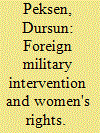

|
|
|
|
|
| Publication |
2011.
|
| Summary/Abstract |
A large body of scholarly work has been devoted to the possible consequences of foreign military intervention for the target state. This literature, however, tends to be state-centric and mostly neglects the insight from gender-specific theoretical and empirical perspectives. The purpose of this article is to examine the extent to which military intervention affects women's rights. It is argued that unilateral interventions are prone to diminishing women's status by encouraging the persistence or creation of repressive regimes and contributing to political disorder in the target state. If the use of armed forces ever helps or causes no damage to women's well-being, it will likely be during interventions led by intergovernmental organizations (IGOs). This is because IGO interventions are unlikely to protect or support an authoritarian, patriarchal political system. Furthermore, such multilateral missions will increase international awareness of women's status along with other human rights issues in the target society, thereby creating more pressure on the government to enforce women's rights. To empirically substantiate these arguments, three different indicators that tap socio-economic and political aspects of women's status are used, including the indices of women's economic, political, and social rights from the Cingranelli-Richards database. The results indicate that while women's political and economic status suffer most during unilateral US interventions, IGO interventions are likely to have a positive influence on women's political rights. Non-US unilateral interventions, on the other hand, are unlikely to cause any major change in women's status. Finally, military interventions in general have no major statistically significant impact on women's social rights.
|
|
|
|
|
|
|
|
|
|
|
|
|
|
|
|
| 12 |
ID:
132021
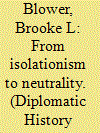

|
|
|
|
|
| Publication |
2014.
|
| Summary/Abstract |
This essay assesses the pitfalls of relying on isolationism to describe American political culture during the 1920s and 1930s and proposes that the concept of neutrality offers a more useful framework for understanding how Americans struggled with their place in a world at war. Americans had long worried about foreign entanglements, but what lent the debates after World War I their special urgency and potency was a sense that one important option in the traditional conduct of international relations-neutrality-had become unhinged from its moorings. Understanding the shifting meanings, and ultimately the perceived demise of neutrality as a viable form of statecraft, points toward a new way to narrate the turning points and political alliances of the interwar years. It also helps to explain why, since the 1930s, Americans have become more readily embroiled in military conflicts overseas despite their recurring doubts about the price of such engagement.
|
|
|
|
|
|
|
|
|
|
|
|
|
|
|
|
| 13 |
ID:
133775
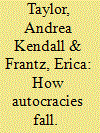

|
|
|
|
|
| Publication |
2014.
|
| Summary/Abstract |
Because autocrats can rarely be voted out of power, most find themselves exiting office in far less conventional ways. Since the 1950s, the coup d'état-or the illegal seizure of power by the military-has been by far the most common.1 During the 1960s and '70s, for example, about half of all autocrats who lost power did so through a coup. But fast-forward to the 2010s, and a different picture is emerging. The chain of protests during the Arab Awakening, which toppled four of the world's longest-standing rulers-Zine al-Abidine Ben Ali of Tunisia, Hosni Mubarak of Egypt, Muammar Qaddafi of Libya, and Ali Abdullah Saleh of Yemen-led many political observers to rejoice in the masses' ability to unseat autocratic strongmen. But are these revolts evidence that autocrats are becoming increasingly vulnerable to the masses? Or are they short-term exceptions to a longer-standing rule of autocratic ouster?
|
|
|
|
|
|
|
|
|
|
|
|
|
|
|
|
| 14 |
ID:
124377
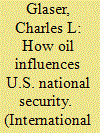

|
|
|
|
|
| Publication |
2013.
|
| Summary/Abstract |
How do states' oil requirements influence U.S. national security? Although a great deal of attention has focused on "energy security," scholars and policymakers lack satisfactory answers because little analysis links states' energy requirements with the probability of military conflict. Developing an analytic catalogue of the ways in which states' oil requirements could influence U.S. national security is the first step in closing this gap. Possible mechanisms include vulnerable access to oil that threatens a state's military capability; military policies designed to protect access to oil that threaten another state's military capability, which in turn create an access-driven security dilemma; and oil reserves that increase the value of territory, generating a conflict that draws in the United States via an alliance commitment. A distinctive feature of this framework is that some of these mechanisms identify threats to U.S. security that flow from another country's consumption of oil, not from U.S. consumption. Of particular importance is the potential danger that Chinese oil imports create for U.S. security-China's efforts to protect its sea lines of communication are fueling military competition that could strain U.S.-China relations and increase the probability of conflict between them. Policy options for dealing with these dangers share little with the standard options prescribed for dealing with the dangers related to Persian Gulf oil and U.S. oil consumption.
|
|
|
|
|
|
|
|
|
|
|
|
|
|
|
|
| 15 |
ID:
119305
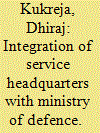

|
|
|
| 16 |
ID:
117447
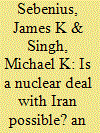

|
|
|
|
|
| Publication |
2012.
|
| Summary/Abstract |
Varied diplomatic approaches by multiple negotiators over the past several years have failed to conclude a nuclear deal with Iran. Mutual hostility, misperception, and flawed diplomacy may be responsible. Yet, more fundamentally, no mutually acceptable deal may exist. To assess this possibility, a "negotiation analytic" framework conceptually disentangles two issues: (1) whether a feasible deal exists; and (2) how to design the most promising process to achieve one. Focusing on whether a "zone of possible agreement" exists, a graphical negotiation analysis precisely relates input assumptions about the parties' interests, their no-deal options, and possible deals. Under a plausible, mainstream set of such assumptions, the Iranian regime's no-deal options, at least through the fall of 2012, appear superior to potential nuclear agreements. If so, purely tactical and process-oriented initiatives will fail. Opening space for a mutually acceptable nuclear deal-one that avoids both military conflict and a nuclear-armed or nuclear-capable Iran-requires relentlessly and creatively worsening Iran's no-deal options while enhancing the value of a deal to the Iranian regime. Downplaying both coercive options and upside potential, as international negotiators have often done, works against this integrated strategy. If this approach opens a zone of possible agreement, sophisticated negotiation will be key to reaching a worthwhile agreement.
|
|
|
|
|
|
|
|
|
|
|
|
|
|
|
|
| 17 |
ID:
128577


|
|
|
|
|
| Publication |
2013.
|
| Summary/Abstract |
This article sets out some personal views on leadership and junior officer development from the viewpoint of a warfare branch Lieutenant. The author is currently serving as the RN exchange officer at the Royal Military Academy, Snadhurst and considers an understanding of capabilities across the services vital in the joint efforts required by current conflicts
|
|
|
|
|
|
|
|
|
|
|
|
|
|
|
|
| 18 |
ID:
128672
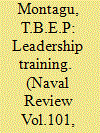

|
|
|
|
|
| Publication |
2013.
|
| Summary/Abstract |
An article written by the RN's exchange officer at the Royal Military Academy Sandhurst who deployed to Kabul as part of a mentor team for the Afghan National Army Officer Academy (ANAOA). The project is set to be the UK's enduring commitments to Afghanistan after the 2014 drawdown. The author highlights the challenges of the project from the political level through on the ground mentoring.
Leadership training
|
|
|
|
|
|
|
|
|
|
|
|
|
|
|
|
| 19 |
ID:
108545


|
|
|
| 20 |
ID:
130660
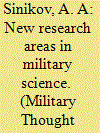

|
|
|
|
|
| Publication |
2014.
|
| Summary/Abstract |
The article examines trends in military science that use field categories borrowed from conflict and crisis studies. Topics discussed include the differentiation between military science as a field of study to military conflict studies, the inventory of theories included in military science, origins of the view that military conflict is more general than war. It cites trends in military conflicts that can serve as grounds for formulating scientific regularities in the course of research.
|
|
|
|
|
|
|
|
|
|
|
|
|
|
|
|
|
|
|
|
|